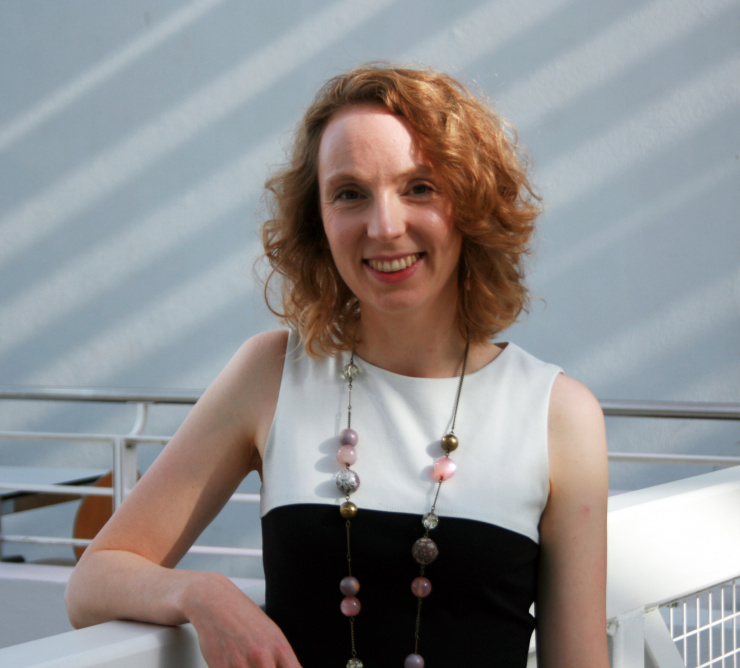Entretien
Spotlight on… Lucile Davier

Lucile Davier has been an assistant professor in the French Unit of the FTI’s Translation Department since July 2022. As a specialist in news translation, she holds a PhD in translation studies and communication sciences and has numerous publications under her belt. Thanks to funding from the Swiss National Science Foundation, she was invited to KU Leuven (Belgium) as a visiting scholar (2012-2013) and the University of Ottawa (Canada) as a postdoctoral researcher (2016-2017). From 2014 to 2022, she was a research and teaching fellow in the French Unit of the Translation Department, teaching courses at the BA, MA and doctoral level. Today, she will be talking to us about the particularities of news translation and describing how this field has led her to new research on volunteer translation.
Lisez cet entretien en français
What piqued your interest in news translation?
My passion for the media! After my studies in translation, I did an MA in information and communication at the University of Geneva. I realised that journalists are often confronted with issues of translation, whether they are covering events in a multilingual country or dealing with international news. I was fascinated by how journalists tend to distance themselves from translation (or, at least, their understanding of translation), even if they carry out micro-level transfer operations on a daily basis. That’s why I decided to examine how translation can influence the news. News translation appeals to me because it remains on the margins of translation studies. It’s hard to find full translations of newspaper articles, even though translation is omnipresent, whether we’re dealing with a French article on the results of a scientific study published in English, coverage of the federal elections in Switzerland, or the latest news in Ukraine.
What is unique about news translation?
It takes on many different forms, which is what makes it so challenging to grasp. It’s rare for a journalistic text have a single source, unlike other types of translation. An article may compile several sources, including some written in other languages. An article that hasn’t been translated may contain multiple sporadic translations (words, expressions or quotes). Translation may also precede the published article, for example, if the article is based on a press release that was already translated by an organisation. Since so many people participate in producing a piece of published news (drafting, verification, editing, layout, etc.), it’s often impossible to identify who has translated which passages.
Furthermore, translation is often invisible in the media. Journalists don’t consider what they are doing to be translation, instead describing it as reporting with the help of sources in other languages. In addition, translation – and even multilingualism – is often effaced in press articles. We rarely find phrases like “translated from German by…” or “she explained in Ukrainian”. I’ve also noticed that reporters tend to avoid using clips where people are speaking in another language. As a result, when dealing with news sources, we’re often misleadingly presented with a monolingual façade.
What are the main challenges in this field?
The particularities of news translation present a certain number of conceptual and methodological challenges.
From a conceptual point of view, translation studies is not equipped to deal with scenarios in which there is no source text, since we tend to discuss translation in very binary terms (source text/target text; faithful/free; translation/adaptation, etc.).
From a methodological point of view, a straightforward analysis of the text is not sufficient to identify the translated passages, which are often presented as having been written in the language of the article. Putting together parallel corpora (containing source texts aligned with target texts) is therefore almost impossible in the media sector. Instead, we can better understand what elements are translated and how they are translated by going out in the field to meet journalists, as I did in Switzerland and Canada. Even with this approach, in many cases, it’s impossible to ascertain whether or not certain passages have been translated. The task is rendered even more complicated by the growth of new types of media (for example, videos, podcasts, computer graphics and social media posts). While the internet allows us to easily get a hold of texts in huge databases, it’s harder to find audio and video files.
What solutions may be out there?
From a theoretical point of view, I think that we simply have to broaden existing definitions (for example, the definition of “source text”) and not become trapped in binary oppositions (what is translation vs. what is not translation). From a methodological point of view, field studies provide us with some promising leads. The digital humanities have opened up new paths that are worth developing further. As for media databases, my hope is that they will increasingly include more multimodal content and index it in a way that is accessible.
How did news translation lead you to volunteer translation? Can you tell us more about this line of research?
News translation is related to “non-professional translation”, a field that is rapidly growing. Journalists who translate are not trained as translators. When I was at a conference, I discovered other types of non-professional translation. I was particularly struck by studies on committed approaches to translation, for example, for the benefit of migrants or minorities. As a teacher, I’ve seen how these kinds of topics mobilise students. One thing led to another, and I decided to examine volunteer translation in an association that promotes vegetarianism and veganism. I was surprised to find that among the volunteers, there were as many people without translation experience as there were seasoned translators. All the volunteers had one thing in common: they were vegan. The association highlights the importance of this dietary choice when they recruit. Here, we’re talking about an issue of identity (can you translate for a vegan cause if you’re not vegan?) that is critical, as demonstrated by the polemic unleashed by the translation of Amanda Gorman’s poem. I like it when my research is in sync with issues that preoccupy not only translators, but society as a whole. This question of identity can be tackled from different perspectives and give rise to a variety of other studies.
